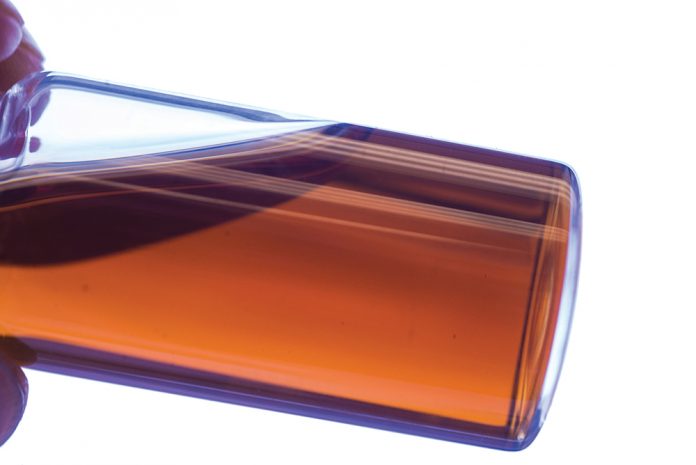The team at William Blythe Ltd explains how graphene oxide production has been scaled up to meet increased global demand for the novel material.
What is graphene oxide?
Graphene oxide (GO) is a derivate of graphene, the 2-dimensional material discovered at the University of Manchester by Nobel Prize winning scientists Andre Geim and Kostya Novoselov.
Like graphene, GO is made up of a single layer of carbon atoms arranged in a 2D hexagonal lattice. This structure gives the material remarkable strength, thermal conductivity and sensing properties. In contrast to graphene, GO has oxygenated functional groups distributed across the ‘sheet’, which disrupt the delocalised electron structure and lead to greatly reduced electronic properties.
These oxygen-containing groups do however enable greater functionality in dispersing the single layers across a range of systems, and can be functionalised to tune the hydrophilic properties.
Manufacturing Graphene Oxide
The two most common manufacturing routes for GO are by electrochemical oxidation of solid graphite (e.g. graphite rods) and wet chemical oxidation of graphite powder. For scalability and reproducibility of consistent material, the latter process is desirable, and was the method chosen by the William Blythe chemists when the R&D work began in 2015.
Coincidently, the first reported synthesis of GO or “graphic acid”, as it was stated in this paper, was published in 1859 by Benjamin Brodie [1], 14 years after William Blythe Limited was incorporated. Brodie’s method employed potassium chlorate and fuming nitric acid as the strong oxidiser & acid combination required to intercalate between the graphite layers and react with the delocalised electron structure.
Over the years this method has been optimised in academia to improve its safety, resulting in the most common method now employed commercially, the Hummers method. This method utilised sodium nitrate and potassium permanganate in concentrated sulfuric acid to produce a GO material with a high oxygen content, an important property that correlates strongly with a high yield of single-layered GO.
Transfer from Lab to Plant
As commercial demand for William Blythe GO increased in 2020, the decision was made to transfer the optimised lab method to the next stage in scale-up. Early in the process, the operations team highlighted a few key challenges:
1. Temperature Control = heating is required for maximum oxidation, however too high temperatures can lead to safety concerns. This therefore requires significant temperature control and the relevant safety interlocks.
2. Addition Rate & Sequence = like many chemical processes, the addition rate is key in controlling product properties and any exotherms arising from the addition of acids and oxidising agents.
3. Oxidiser Quenching = strong oxidising agents require quenching post reaction to ensure safe waste streams at the end of the process. Controlling this process to ensure limited temperature variation is critical for safe operation.
4. Purification = nanomaterials can be difficult to purify through conventional methods as a result of their tiny size and in the case of GO, 2D sheet-like morphology.
To combat these, a combination of R&D and Operations worked through the relevant hazard studies to ensure that the safest process was being pursued, worst-case scenarios analysed & mitigations implemented, and all occupational hazards taken into account during the plant design phase. This was all supported by the top tier COMAH site status and decade’s worth of experience the company has in safely handling hazardous chemistries.
Another key enabler to scaling up the Hummers method is William Blythe’s on-site wastewater treatment plant, which is well equipped to handle the large quantities of acids and the oxidising agent by-products, ensuring a safe effluent stream. The team is now working on routes to recycle the sulfate waste in existing processes, in pursuit of more circularity within the manufacturing site. All of the above led to the development of a safe production route, but the last remaining challenge was to ensure the high purity remained from lab to plant. Utilising internal know-how and significant R&D efforts, a scalable purification method was developed to produce a high-quality material with very low batch to batch variability.
Application & Commercialisation
For those informed in the graphene space, you’ll know it has been researched across hundreds of different applications. Given the hype, William Blythe has been careful in selecting key application areas for internal developments of its material. Whilst the William Blythe GO has been used in gas sensing [2], CO2 capture [3] and biomedical [4] applications in academia, the company has also explored it’s use in water purification and energy storage in commercial UKRI projects. The current drivers for the scale-up to a 50-tonne/year capacity are in filtration and polymer additive applications, and the company continues to work with partners in other areas to help commercialise this nanomaterial.
References
1. Royal Society, 1859, 149, pp.249-259
2. Carbon Trends, 2021, 5 (100123), pp.1-7
3. Advanced Functional Materials, 2020, 30 (40)
4. Dental Materials, 2019, 35(11), pp.1614-1629









